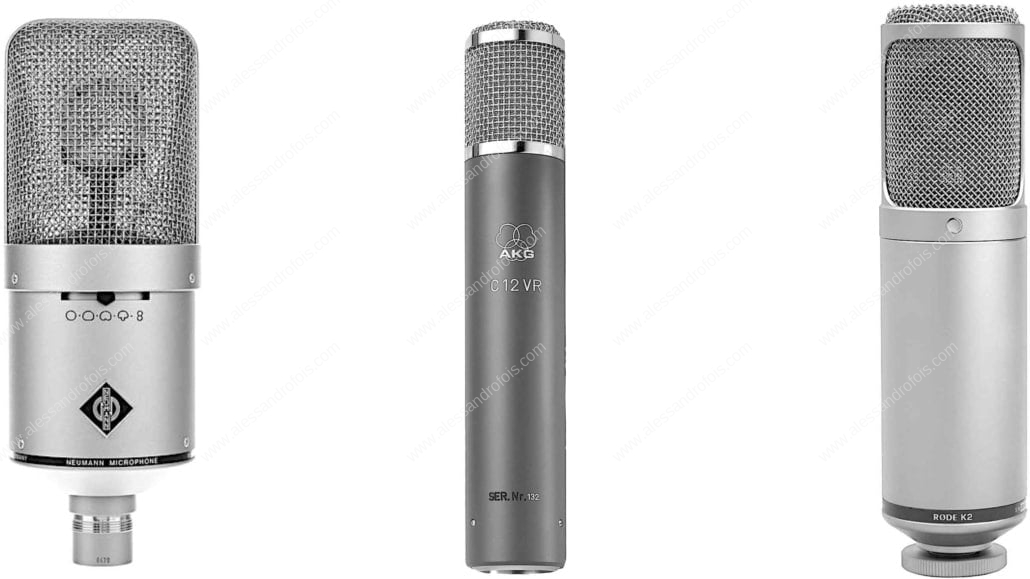Recording your voice (02) The microphone
- Author Profile
- Recent posts
Pianist, Composer, Arranger, Sound Engineer, Writer, Blogger
Alessandro Fois is a musician, composer, pianist, arranger and sound engineer. Since 2018, he has also been a writer, blogger and webmaster. He currently resides in Ivrea (Turin) where, in addition to the above activities, he manages Lycnos, studio for audio, video and web services, and the recording studio Glamour Recording Studio.
Choice of microphone.
Choosing the right type of microphone is an important element for a good vocal pick-up result.
CONDENSER OR DYNAMIC
For a good recording of vocals in the studio, a condenser microphone will generally prove to be more suitable due to its higher overall fidelity and greater sensitivity (which will allow more tonal and dynamic detail to be captured).
If well chosen, a good microphone will have a sufficiently high mechanical strength to withstand even the exasperated dynamics of 'screamers'.
WIDE OR NARROW DIAPHRAGM
A wide-diaphragm condenser microphone will generally be preferable for a solo voice, because it will offer greater resistance to detonating and blowing consonants (especially at close range) and because it will produce a warmer and softer result (although in some respects it will be a little less 'faithful' than a narrow-diaphragm microphone).
Even a high-quality narrow-diaphragm (stylus) condenser, used at distances greater than 30 cm, with the right inclination and protected by an anti-pop sock, will still produce high-precision results, characterised by a very neutral colouration.

On the left some wide-diaphragm condenser microphones and on the right some narrow-diaphragm models. The former are generally better suited for recording solo vocals.
VALVE OR NOT
The tube microphone or, alternatively, the tube preamplifier, are capable of giving the sound some additional harmonics, resulting from a slight non-linear saturation.
This could give the sound an adaptive tonal enrichment, varying according to the different tonal and dynamic stresses determined by the singer in each performative instant.
This choice is generally viewed positively, due to the 'warmer' and 'richer' sound thus generated.
Sometimes, however, it may be perceived negatively, as it causes 'sound dirt', resulting from the superimposition of the harmonics generated by the valves, which in some cases may appear as slight distortion.
It will therefore be necessary to assess from case to case (and from item to item) which solution should be adopted.
To avoid the superimposition of multiple 'layers' of harmonic saturation, it will generally be inadvisable to use the tube microphone in conjunction with the tube preamplifier.


Here are three excellent tube microphones, in the offerings of Neumann, AKG and Rode; the first two have made recording history and have a very high price. The third, more modern, boasts more than excellent value for money.
POLAR FIGURE
The polar figure of the microphone describes its directive capacity.
For a reprise of the solo voice, a directional microphone with figure cardioid.
In the case of close-up shooting (up to 20 cm), a standard cardioid with the usual shooting angle of around 120° is generally preferable.
In the case of less close shooting, a narrow cardioid microphone (pick-up angle of about 80-90°) might be a better choice in order to limit the incidence of ambient resonance.
The narrow cardioid is also advisable in the case of closer resonance, where it is intended to be very limited.
At close range, however, the narrow cardioid will be more sensitive to the movements of the singer's head, thus risking losing some 'details' that may be accidentally 'out of focus'; in this case, it would be a good idea to advise the singer to always point the mouth towards the capsule.
If an unshielded hypercardioid is used at the rear, it will be advisable to place a sound-absorbing screen behind it in order to prevent ambient reverberation from returning to the rear.

A diagram with various microphone polar figures
TONAL AND DYNAMIC CHARACTERISTICS
The issue here is to achieve the best possible coupling between various microphones and voice types.
Obviously, in a small studio equipped with a single wide-diaphragm condenser microphone, this distinction will not be taken into account as one will have to record each voice with the same microphone; but where it is possible, it might be important to make a judicious choice.
Merely as a personal example, having a Neumann U87, an Akg 414 ULS and a Rode K2 valve, I would generally lean towards:
- the Neumann for timbrally clear male voices, especially with a low range
- the Akg for high and/or thin female voices
- the Rode K2 for all other standard applications
The above is, of course, a general guideline derived from my personal experience; in reality, each voice is a universe in itself, so it may be useful to attempt a comparison, if not even to use a simultaneous shot with two microphones (in which case they should be well in phase, in order to assess the possibility of using both at the same time).
Using the microphone
Many singers are well versed in the use of the dynamic stage microphone, and know how to vary its distance and angle at any given moment of the performance, in order to compensate for different vocal emissions and homogenise the result.
Some, on the other hand, are not able to handle the above with as much expertise, others do not even try.
Interaction with the microphone, if handled more moderately than live, is also a good thing to observe in the recording studio.
In the case of filming at a high distance (30 cm and above), however, it will be better to refrain from any compensatory movement, except for a slight rapprochement for singing the vocal parts in sub-voice.
At a certain distance, in fact, it will be easier to attenuate excess volume than to give gain to parts that are too low in volume due to the singer being too far away.
This article was extracted from the Handbook
Available in eBook and paperback >
To find out the contents of the Manual and to purchase click here >






Leave a Reply
Want to join the discussion?Feel free to contribute!